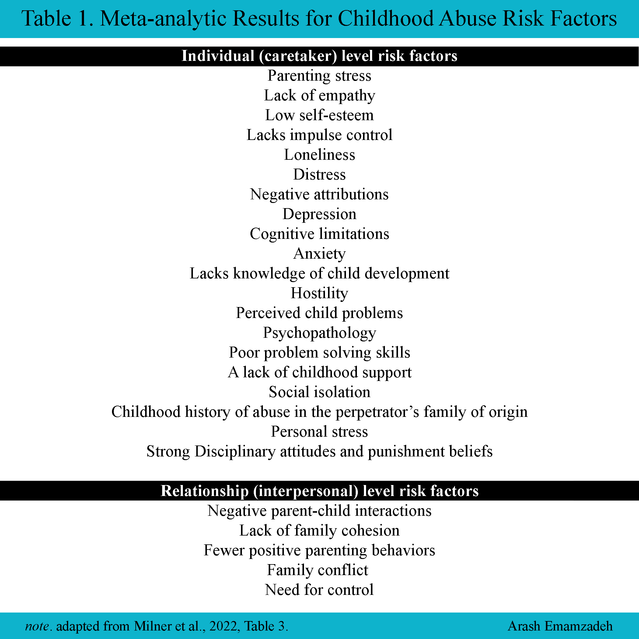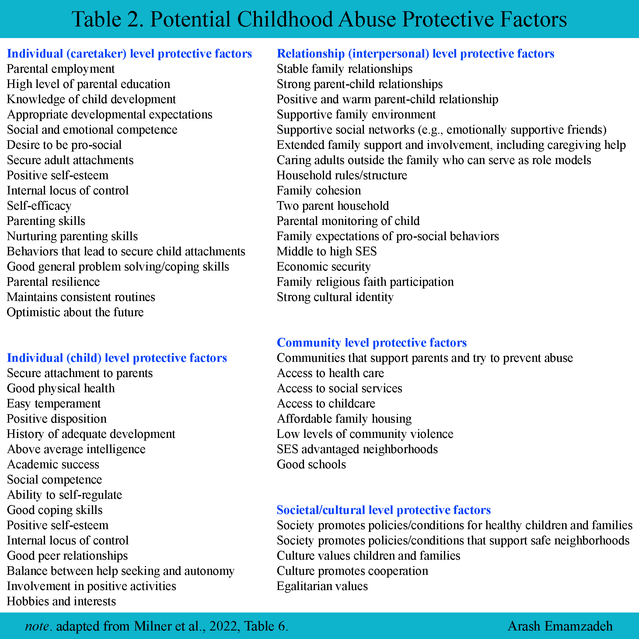Child Development
Research Reveals 25 Risk Factors for Childhood Abuse
Uncovering major parental and relational risk factors.
Posted December 16, 2022 Reviewed by Gary Drevitch
Key points
- Childhood physical abuse is a prevalent social problem. It may result in psychological trauma, physical injury, and even death.
- A recent review of research finds 25 major risk factors for childhood physical abuse, both at the caretaker level and the relationship level.
- Parent-related risk factors include, among others, feeling stressed, lack of empathy, impulse control problems, low self-esteem, and loneliness.
Published in Aggression and Violent Behavior, a recent study by Milner et al., of the Center for the Study of Family Violence and Sexual Assault at Northern Illinois University, reviews potential protective and risk factors for child physical abuse. (Note: Physical abuse includes physical assault, hitting, shaking, choking, kicking, and spanking, particularly if harsh or excessive.)
Investigating the risk factors and protective factors for childhood maltreatment
Of the studies identified through a database search and other resources, 58 were included in the meta-analysis, including 300 effect size estimates.
The total sample included 3,576 individuals (sizes ranging from 14 to 294), with just over half of them being minorities. The average sample size was 26. Mean age was 30 years old. The findings of this review and meta-analysis revealed small and medium caretaker-level and relationship-level risk factors, as described below. See Table 1.

Risk factors for childhood abuse
Child abuse risk factor domain effect size estimates (medium): Twelve risk factors at the caretaker level: parenting stress, hostility, low empathy, low self-esteem, impulsiveness, loneliness, distress, anxiety, depression, lack of cognitive abilities, limited knowledge of child development, and making negative attributions (assuming most actions are motivated by negative intentions). Three risk factors at the relationship level: negative interactions between child and caregiver, low family cohesion, and limited number of positive parenting behaviors.
Child abuse risk factor domain effect size estimates (small): Eight risk factors at the caretaker level: perceived child problems, mental illness, limited problem-solving abilities, lack of childhood support, stress, isolation, childhood history of maltreatment (in the perpetrator’s family), and disciplinary attitudes and strong punishment beliefs. Two risk factors at the relationship level: family conflict and a strong need for control.
Summary
So, looking at the medium risk factors, it seems that physical abusers differ from non-abusers in a number of important ways.
Specifically, abusers are generally more likely to experience low self-esteem, parenting stress, distress, anxiety, depression, hostility, cognitive limitations, and impulse control problems. Furthermore, they tend to have limited empathy, feel alone and isolated, make negative attributions, have inadequate knowledge of child development, engage in fewer positive parenting behaviors, have more negative interactions with their child, and report lower family cohesion.
The predictive validity of the above risk factors appears to be cumulative. This means most people with only a couple of these risk factors (e.g., history of having been abused, mental illness) do not end up harming their children.
Potential protective factors for child maltreatment
A potential list of protective factors—those that decrease the probability of childhood maltreatment—examined in previous research is listed in Table 2. These factors are not specific to childhood physical abuse but to childhood maltreatment in general.

As can be seen, many of these are the reverse of the risk factors we explored earlier. For instance, social support is a protective factor, whereas social isolation and a lack of social support are risk factors. Similarly, knowledge of child development may protect against maltreatment, whereas lack of knowledge increases the probability of child maltreatment.
Note: Protective factors are not necessarily a cure or treatment, just as the risk factors are not necessarily causes but markers of child abuse. This is because the available data do not allow us to draw causal conclusions.
Having said that, knowledge of correlates of childhood abuse is very useful for guiding future research on potential causes and effective interventions for childhood abuse. In addition, knowledge of these correlates may help us protect children whose parents have a high cumulative risk of maltreating and abusing their children. This is important because child abuse may result in depression, psychological trauma, self-harm, physical injury, and even death.


